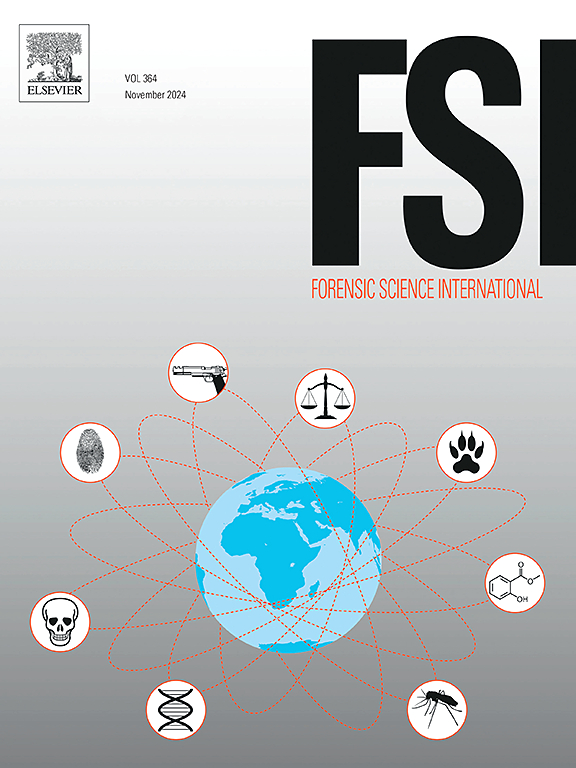“奶酪船长”的法医工具箱:干酪嗜蝇(L.)幼体鉴定和幼体热需求(双翅目:嗜蝇科)
IF 2.5
3区 医学
Q1 MEDICINE, LEGAL
引用次数: 0
摘要
“奶酪船长”,干酪嗜蝇(L.)(双翅目:嗜蝇科),是一种世界性和合生的物种,经常在腐烂晚期的尸体上定居。尽管它具有作为法医指标的潜力,但在案件工作中使用casei P.受到以下因素的阻碍:(i)对其幼虫形态的一些相互矛盾的描述,这限制了在法医现场收集的标本鉴定的可靠性;(ii)缺乏参考数据和温度依赖模型,这阻碍了基于该物种发育率的最小死后间隔(minPMI)估计的准确性。在这里,我们确定和说明了一系列的诊断形态特征,允许明确鉴定干酪样疟原虫的幼虫标本。幼虫头咽骨骼硬化的形状和程度以及腹侧爬行纹的刺行数和排列不仅对物种鉴定,而且对幼虫的龄期测定都特别有用。此外,我们分析了温度对干酪鸡不同未成熟阶段发育的影响,提供了一个同构图,并确定了五个发育事件的热需求(较低的发育阈值和热总和常数),从而能够在法医案例中准确估计最小pmi。此外,在蛹内,我们确定了一系列年龄特异性的形态标记,这些标记很容易通过半透明的羽壳观察到,从而提高了minPMI估计的准确性,并避免了在使用羽壳样本时在羽壳解剖过程中损坏样本的潜在风险。本文章由计算机程序翻译,如有差异,请以英文原文为准。
A forensic toolkit for the “cheese skipper”: Larval identification and thermal requirements of the immature stages of Piophila casei (L.) (Diptera: Piophilidae)
The ‘cheese skipper’, Piophila casei (L.) (Diptera: Piophilidae), is a cosmopolitan and synanthropic species that frequently colonises cadavers in advanced stages of decomposition. Despite its potential as a forensic indicator, the use of P. casei in casework is hampered by (i) some contradictory descriptions of its larval morphology, which limit the reliability of the identification of specimens collected at the forensic scene, and (ii) the lack of reference data and temperature-dependent models, which hinders the accuracy of minimum postmortem interval (minPMI) estimates based on the developmental rates of this species. Here we determine and illustrate a series of diagnostic morphological characters that allow for the unequivocal identification of P. casei larval specimens. The shape and degree of sclerotization of the larval cephalopharyngeal skeleton and the number and arrangement of the rows of spines of the ventral creeping welts are particularly useful allowing not only for species identification, but also for larval instar determination. In addition, we analyse the influence of temperature on the development of the different immature stages of P. casei, providing an isomorphen diagram and determining the thermal requirements (lower developmental threshold and thermal summation constant) for five developmental events, enabling accurate minPMI estimates in forensic casework. In addition, within the intra-puparial period, we determine a series of age-specific morphological markers that are easily observable through the translucent puparium of P. casei, thus increasing the accuracy of minPMI estimates and avoiding the potential risk of sample damaging during puparium dissection when using puparial samples.
求助全文
通过发布文献求助,成功后即可免费获取论文全文。
去求助
来源期刊

Forensic science international
医学-医学:法
CiteScore
5.00
自引率
9.10%
发文量
285
审稿时长
49 days
期刊介绍:
Forensic Science International is the flagship journal in the prestigious Forensic Science International family, publishing the most innovative, cutting-edge, and influential contributions across the forensic sciences. Fields include: forensic pathology and histochemistry, chemistry, biochemistry and toxicology, biology, serology, odontology, psychiatry, anthropology, digital forensics, the physical sciences, firearms, and document examination, as well as investigations of value to public health in its broadest sense, and the important marginal area where science and medicine interact with the law.
The journal publishes:
Case Reports
Commentaries
Letters to the Editor
Original Research Papers (Regular Papers)
Rapid Communications
Review Articles
Technical Notes.
 求助内容:
求助内容: 应助结果提醒方式:
应助结果提醒方式:


